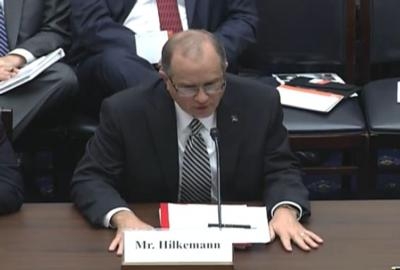Tue, Jan 27, 2015
Appreciates Efforts To Provide Greater Consistency In That Regard
The General Aviation Manufacturers Association (GAMA) issued a statement wecoming two developments last week in the effort to provide greater consistency in regulatory interpretation: a U.S. House Transportation and Infrastructure Committee hearing on the issue and the concurrent release of a detailed FAA plan to implement recommendations resulting from Section 313 of the FAA Modernization and Reform Act of 2012.

On January 21, 2015, Duncan Aviation President and CEO Aaron Hilkemann (pictured), who is GAMA’s Vice Chairman, testified before the committee on the need for greater consistency in regulatory interpretation and a timely resolution process. Hilkemann discussed the work of the Consistency of Regulatory Interpretation Aviation Rulemaking Committee, which, in November 2012, made six recommendations to improve the regulatory process. In his testimony, Hilkemann highlighted two of these recommendations that would help resolve issues of uncertainty. The first would establish a single master source regulatory database of regulations and all related policy, guidance, and interpretive information in a readily available and searchable format to FAA and industry. The second would set up a Regulatory Consistency Communications Board (RCCB)—comprised of FAA regulatory and policy experts—to provide guidance and independent assessment on the interpretation and application of
regulations.
“We appreciate the House Transportation and Infrastructure Committee focusing attention on this important issue of regulatory inconsistency as they work toward reauthorization of the FAA later this year,” said GAMA President and CEO Pete Bunce. “This hearing pinpointed some of the challenges that exist as well as opportunities to work together toward a more efficient and effective certification process for general aviation businesses and owner/operators in the future.”
Also on January 21, 2015, the FAA released a detailed plan to implement recommendations resulting from Section 313, Consistency of Regulatory Interpretation, of the FAA Modernization and Reform Act of 2012.
“We are very pleased that the FAA is moving forward with the first step of an implementation process for Section 313 recommendations. This effort must have priority within the agency and be closely monitored by Congress,” Bunce said. “We also hope that the agency will make the RCCB available as soon as possible to industry, not only to FAA inspectors. We look forward to working with the FAA as it continues to improve current processes and allow general aviation repair stations and manufacturers to deliver their innovative services and products to customers in a more efficient and timely manner.”
(Image from file)
More News
Circle To Runway (Runway Number) Used by ATC to inform the pilot that he/she must circle to land because the runway in use is other than the runway aligned with the instrument appr>[...]
Aero Linx: National Aviation Safety Foundation (NASF) The National Aviation Safety Foundation is a support group whose objective is to enhance aviation safety through educational p>[...]
At Altitude Of About 250-300 Ft Agl, The Airplane Experienced A Total Loss Of Engine Power On November 6, 2024, at 1600 central standard time, a De Havilland DHC-1, N420TD, was inv>[...]
From 2009 (YouTube Edition): Three Hour Flight Was 'Flawless' -- At Least, Until Mother Nature Intervened For anyone who loves the aviation business, this was a VERY good day. Afte>[...]
Also: AMA Names Tyler Dobbs, More Falcon 9 Ops, Firefly Launch Unsuccessful, Autonomous F-16s The Air Force has begun ground testing a future uncrewed jet design in a milestone tow>[...]
 ANN's Daily Aero-Term (05.05.25): Circle To Runway (Runway Number)
ANN's Daily Aero-Term (05.05.25): Circle To Runway (Runway Number) ANN's Daily Aero-Linx (05.05.25)
ANN's Daily Aero-Linx (05.05.25) NTSB Prelim: De Havilland DHC-1
NTSB Prelim: De Havilland DHC-1 Classic Aero-TV: The Boeing Dreamliner -- Historic First Flight Coverage
Classic Aero-TV: The Boeing Dreamliner -- Historic First Flight Coverage Airborne-NextGen 05.06.25: AF Uncrewed Fighters, Drones v Planes, Joby Crew Test
Airborne-NextGen 05.06.25: AF Uncrewed Fighters, Drones v Planes, Joby Crew Test



